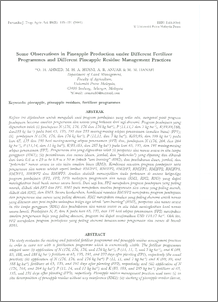Citation
Ahmed, Osumanu Haruna and Mohd Hanif, Ahmad Husni and Abd Rahim, Anuar and Musa, Mohamed Hanafi
(2001)
Some observations in pineapple production under different fertilizer programmes and different pineapple residue management practices.
Pertanika Journal of Tropical Agricultural Science, 24 (2).
pp. 115-121.
ISSN 1511-3701
Abstract
The study evaluates the existing and potential fertilizer programmes and pineapple residue management practices
in order to come out with a fertilization programme which is economically viable. The fertilizer programmes
adopted were: (i) application of N (176, 176, 176, and 176 kg ha-1 ), P (11, 11, 7, and 7 kg herJ), and K (89,
89, 188, and 188 kg ha-1 ) fertilizers at 65, 135, 191, and 233 days after planting (FP1), respectively (the usual
practice); (ii) application of N (176, 176, and 176 kg ha-J
) P (11, 11, and 7 kg herJ) and K (89, 89, and
188 kg ha-J) fertilizers at 65, 135, and 191 days after planting (FP2), respectively; and (iii) application of N
(176,264, and 264 kg ha-1 ) P (11,14, and 11 kg ha-1 ) and K (89,183, and 285 kg ha-J) fertilizers at 65, 135, and 191 days after planting (FP3), respectively. Pineapple residue management practices used were: (i) in situ decomposition of pineapple residue without any interference (RMl); (ii) stacking of pineapple residue (leaves, crowns, and peduncles) slashed, and raked from 0.6 m x 10m beds into 0.9 m x 10m beds (RM2-zero bum technique); and (iii) in situ burning of pineapple leaves, crowns, and peduncles (the usual practice) (RM3). Combinations of the residue management practices and fertilizer programmes gave the following treatments: RM1FP1, RM1FP2, RM1FP3, RM2FP1, RM2FP2, RM2FP3, RM3FP1, RM3FP2, and RM3FP3. Neither of
the fertilization programmes (FP1, FP2, and FP3) nor residue management practices (RM1, RM2, and RM3)significantly improved fruit yield. FP2 emerged as the least expensive programme followed by FP3, and then FP1.
The cheapest residue management practice was RM1, followed by RM2, and RM3. RM1FP2 emerged the most economic treatment combination. Zero-bum technique (RM2), in situ decomposition of pineapple residues without
any interference (RM1), in situ burning of pineapple residues did not significantly improve fruit yield, but
practicing RM1 in pineapple cultivation on tropical peat is economical. Application of N, P, and K fertilizers
at 65, 135, and 191 days after planting (FP2) was cost effective as it was possible to save as much as USD
110.17 ha-J, and this programme was most economically viable under pineapple residue management practice
RM1.
Download File
![[img]](http://psasir.upm.edu.my/style/images/fileicons/application_pdf.png)  Preview |
|
PDF
Some_Observations_in_Pineapple_Production_under_Different_Fertilizer.pdf
Download (4MB)
|
|
Additional Metadata
Actions (login required)
 |
View Item |

